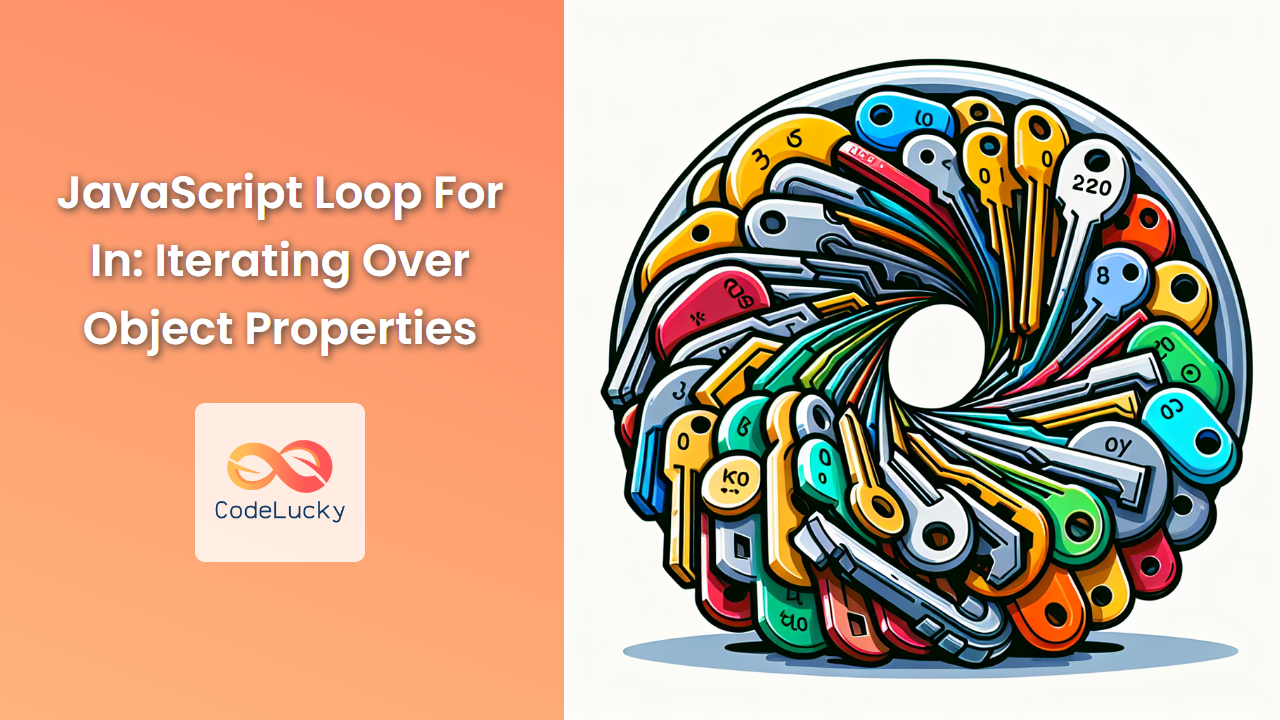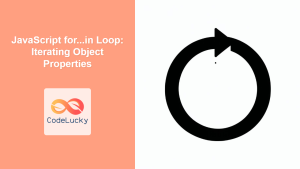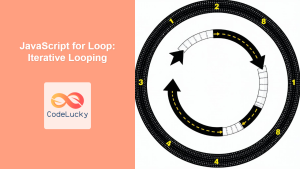JavaScript, a versatile and powerful programming language, offers various ways to iterate over data structures. One such method is the for...in loop, which is specifically designed to iterate over the enumerable properties of an object. In this comprehensive guide, we'll dive deep into the for...in loop, exploring its syntax, use cases, and best practices.
Understanding the for…in Loop
The for...in loop provides a convenient way to iterate through the properties of an object. Its syntax is straightforward and easy to understand:
for (variable in object) {
// code to be executed
}
Here, variable represents the property name in each iteration, and object is the object whose properties you want to iterate over.
Let's start with a simple example to illustrate how the for...in loop works:
const person = {
name: "Alice",
age: 30,
job: "Developer"
};
for (let prop in person) {
console.log(prop + ": " + person[prop]);
}
Output:
name: Alice
age: 30
job: Developer
In this example, we iterate over the person object. In each iteration, prop takes on the name of each property ("name", "age", "job"), and we use it to access the corresponding value using bracket notation (person[prop]).
🔑 Key Points to Remember
- The
for...inloop iterates over all enumerable properties of an object, including inherited properties. - The order of iteration is not guaranteed and may vary between different JavaScript engines.
- It's generally not recommended to use
for...inon arrays, as it can lead to unexpected results.
Handling Inherited Properties
One important aspect of the for...in loop is that it also iterates over inherited properties. Let's see an example:
const animal = {
legs: 4
};
const dog = Object.create(animal);
dog.breed = "Labrador";
for (let prop in dog) {
console.log(prop + ": " + dog[prop]);
}
Output:
breed: Labrador
legs: 4
In this example, dog inherits the legs property from animal. The for...in loop iterates over both the own property (breed) and the inherited property (legs).
To iterate only over an object's own properties, you can use the hasOwnProperty() method:
for (let prop in dog) {
if (dog.hasOwnProperty(prop)) {
console.log(prop + ": " + dog[prop]);
}
}
Output:
breed: Labrador
🚫 Avoiding for…in with Arrays
While it's possible to use for...in with arrays, it's generally not recommended. Here's why:
const fruits = ["apple", "banana", "orange"];
fruits.customProperty = "I'm a custom property";
for (let index in fruits) {
console.log(index + ": " + fruits[index]);
}
Output:
0: apple
1: banana
2: orange
customProperty: I'm a custom property
As you can see, the for...in loop iterates over all enumerable properties, including non-index properties like customProperty. This behavior can lead to unexpected results when working with arrays.
Instead, for arrays, it's better to use for...of loop or the traditional for loop:
for (let fruit of fruits) {
console.log(fruit);
}
// Or
for (let i = 0; i < fruits.length; i++) {
console.log(fruits[i]);
}
Advanced Usage: Dynamic Property Access
The for...in loop shines when you need to work with objects dynamically. Let's look at a more complex example:
const employees = {
engineering: {
john: { salary: 80000, yearsOfExperience: 5 },
jane: { salary: 90000, yearsOfExperience: 7 }
},
marketing: {
sarah: { salary: 70000, yearsOfExperience: 4 },
mike: { salary: 75000, yearsOfExperience: 6 }
}
};
function getTotalSalaryByDepartment(employees) {
const totalSalaries = {};
for (let department in employees) {
let departmentTotal = 0;
for (let employee in employees[department]) {
departmentTotal += employees[department][employee].salary;
}
totalSalaries[department] = departmentTotal;
}
return totalSalaries;
}
console.log(getTotalSalaryByDepartment(employees));
Output:
{
engineering: 170000,
marketing: 145000
}
In this example, we use nested for...in loops to calculate the total salary for each department. The outer loop iterates over departments, while the inner loop iterates over employees in each department.
🛠️ Performance Considerations
While for...in is versatile, it's not always the most efficient option. For simple objects with a known structure, using Object.keys(), Object.values(), or Object.entries() combined with array methods or for...of loops can be more performant:
const person = {
name: "Bob",
age: 35,
job: "Designer"
};
// Using Object.keys()
Object.keys(person).forEach(key => {
console.log(key + ": " + person[key]);
});
// Using Object.entries() with for...of
for (let [key, value] of Object.entries(person)) {
console.log(key + ": " + value);
}
These methods are generally faster because they only iterate over the object's own enumerable properties and don't need to check the prototype chain.
Error Handling in for…in Loops
When using for...in loops, it's important to handle potential errors, especially when dealing with complex or dynamically generated objects. Here's an example of how to implement error handling:
const complexObject = {
a: 1,
b: { c: 2, d: 3 },
e: null,
f: undefined
};
for (let prop in complexObject) {
try {
if (complexObject.hasOwnProperty(prop)) {
if (typeof complexObject[prop] === 'object' && complexObject[prop] !== null) {
console.log(prop + " is an object");
for (let nestedProp in complexObject[prop]) {
console.log(" " + nestedProp + ": " + complexObject[prop][nestedProp]);
}
} else {
console.log(prop + ": " + complexObject[prop]);
}
}
} catch (error) {
console.error("Error processing property " + prop + ": " + error.message);
}
}
Output:
a: 1
b is an object
c: 2
d: 3
e: null
f: undefined
This example demonstrates how to handle different types of properties, including nested objects, null values, and undefined properties.
🌟 Best Practices for Using for…in Loops
-
Always use
hasOwnProperty()check: This ensures you're only working with the object's own properties, not inherited ones. -
Avoid using
for...inwith arrays: Stick tofor...ofor traditionalforloops for arrays. -
Be cautious with modification: Modifying the object you're iterating over can lead to unpredictable results.
-
Consider alternatives for performance-critical code: For known object structures, methods like
Object.keys()might be faster. -
Use meaningful variable names: Instead of generic names like
prop, use descriptive names that indicate what the property represents.
Practical Application: Creating a Deep Clone Function
Let's use our knowledge of for...in loops to create a deep clone function for objects:
function deepClone(obj) {
if (obj === null || typeof obj !== 'object') {
return obj;
}
let clone = Array.isArray(obj) ? [] : {};
for (let key in obj) {
if (obj.hasOwnProperty(key)) {
clone[key] = deepClone(obj[key]);
}
}
return clone;
}
// Test the function
const original = {
a: 1,
b: { c: 2, d: [3, 4] },
e: [{ f: 5 }, { g: 6 }]
};
const cloned = deepClone(original);
console.log(JSON.stringify(cloned) === JSON.stringify(original)); // true
console.log(cloned.b === original.b); // false (deep clone)
This deepClone function uses a for...in loop to iterate over all properties of the object, recursively cloning nested objects and arrays. It demonstrates the power of for...in when working with complex, nested object structures.
Conclusion
The for...in loop is a powerful tool in JavaScript for iterating over object properties. While it has its quirks and potential pitfalls, understanding how to use it correctly can greatly enhance your ability to work with objects in JavaScript. Remember to always consider the specific needs of your project when choosing an iteration method, and don't hesitate to explore alternatives like Object.keys(), Object.values(), or Object.entries() when appropriate.
By mastering the for...in loop and understanding its nuances, you'll be better equipped to handle complex object manipulations and create more efficient, robust JavaScript code. Happy coding!
- Understanding the for…in Loop
- 🔑 Key Points to Remember
- Handling Inherited Properties
- 🚫 Avoiding for…in with Arrays
- Advanced Usage: Dynamic Property Access
- 🛠️ Performance Considerations
- Error Handling in for…in Loops
- 🌟 Best Practices for Using for…in Loops
- Practical Application: Creating a Deep Clone Function
- Conclusion



















